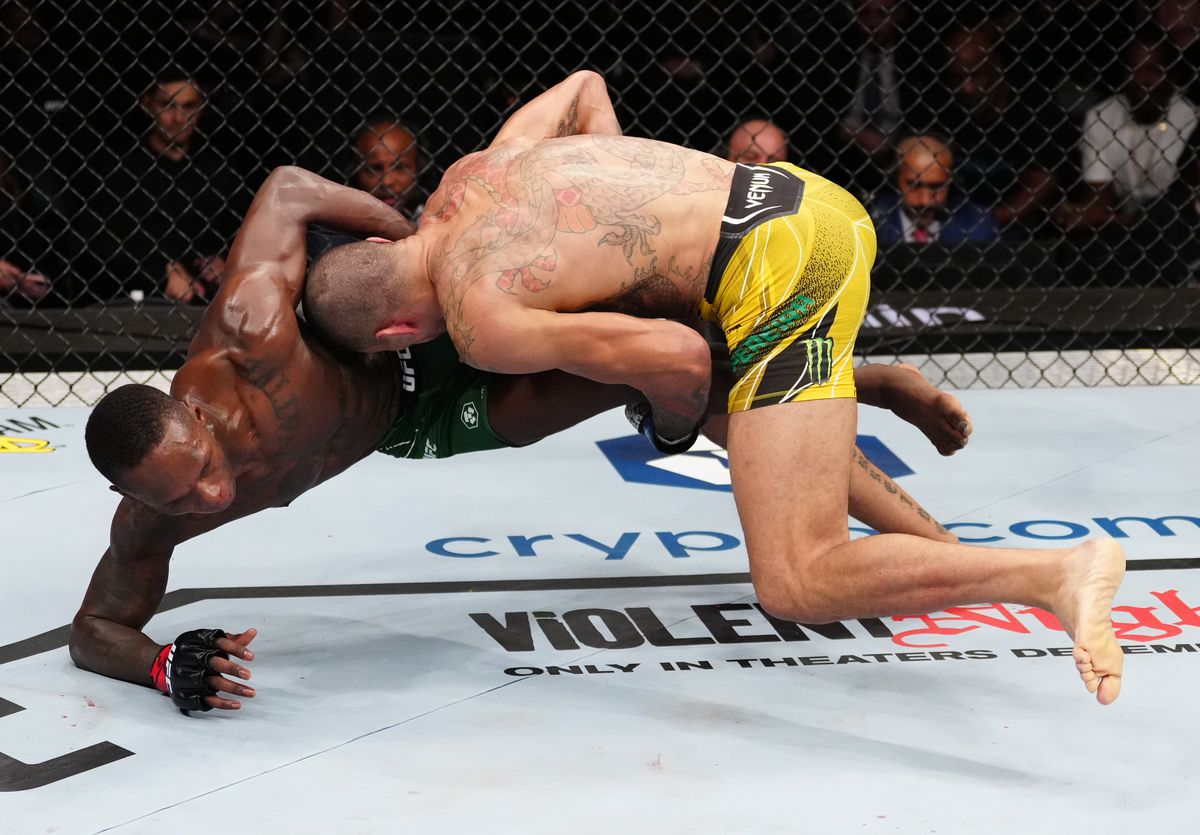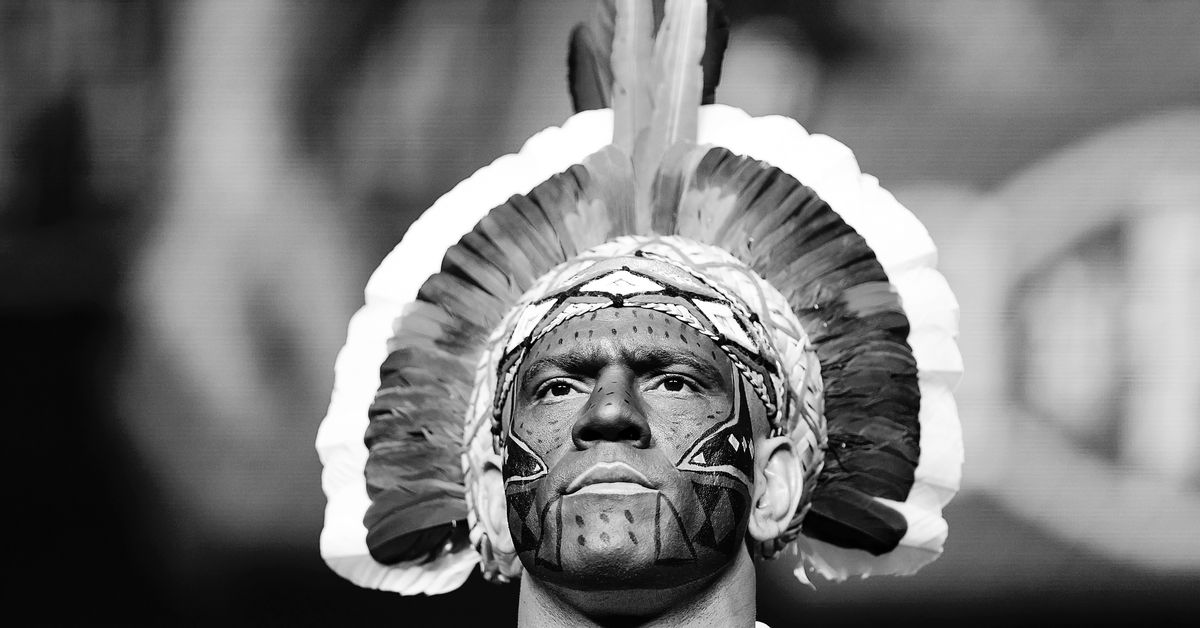Light Heavyweight knockout king, Alex Pereira, looks to score the first defense of his title opposite former champion, Jamahal Hill, TONIGHT (Sat., April 13, 2024) at UFC 300 inside T-Mobile Arena in Las Vegas, Nevada.
Pereira’s rise from kickboxing champion to two-division UFC king is so improbable it’s almost not worth thinking about. Sure, it took extenuating circumstances like a personal rivalry with Israel Adesanya and pair of divisions without many strong wrestlers, but who really cares? Pereira has been consistently spectacular to watch, and he’s achieved in less than three years more than all but a handful of UFC fighters ever will. “Poatan” is simply remarkable, and he has another very reasonable style clash ahead of him against Jamahal Hill.
Let’s take a closer look at his skill set:
Striking
A two-division Glory kickboxing champion, Pereira has a solid claim to being the best knockout artist in the sport right now.
Pereira is a fighter who stalks opponents. He does good work from the kicking range, sure, but the Brazilian invites trades from the pockets. Much of the time, Pereira appears content to work from distance, only to either intentionally close a few more inches or allow his opponent to do so, which can very suddenly introduce a very different dynamic.
At range, Pereira is effective with his kicks and jab. One of the more unique quirks to Pereira’s kicking arsenal is the very kickboxing habit of tying kicks together. Quite often, Pereira will touch his opponent’s mid-section with a switch kick then quickly rip the lead thigh as his opponent backs off. He’ll do the opposite as well, touching low before committing high, which is how he brought a high kick to the chin of Adesanya in the second round of their first MMA bout. Aside from his round kicks, Pereira can snap his right foot into the belly painfully as well.
It probably should be mentioned that Pereira can cover distance with jump knees like few others as well.
Pereira’s calf kick has became a more consistent and devastating weapon in his last three fights. What’s quite interesting is that Pereira throws the strike without much turnover in the hips. Consequently, there’s less power, but there’s also no tell. He’s accurate with his calf kick and still kicks hard enough that it only takes a few to have a major impact.
Pereira’s ability to switch up his rhythm is a huge part of what makes him such a special striker, and the habit of pairing kicks is just one small example. A majority of the time, Pereira is throwing short combinations of his jab, cross/overhand, and left hook. These are the three primary punches of most every fighter in the game, but Pereira separates himself from the pack due to punching form and ability to switch up his timing.
For example, the 2-3 or right hand-left hook combination is pretty fundamental piece of boxing/kickboxing/Muay Thai. Given that Pereira leads with his cross/overhand often, and the fact that his money punch is the left hook, it’s not surprising that Pereira makes good use of the 2-3.
Pereira mixes up that simple combination so well, however. He’ll throw the right as a quick darting cross or as a crushing overhand. Pereira can then follow up with a fast left hook that checks the guard, more rotational power by drifting backwards as he hooks, or a shift forward that has him crashing forward (which is how he knocked out Adesanya the first time in the ring).
Pereira’s stoppage win over Sean Strickland was really a master class in setting up the left hook. Fight fans have openly mocked Strickland for trying to pressure and jab a world class kickboxer, and it’s true that his strategy wasn’t the best. However, it’s also important to understand why Strickland fought how he did, and how well Pereira baited him and played into his confidence.
Strickland routinely pressures MMA fighters. He stands tall, gets in their face, and trusts his ability to parry and slip to keep him safe in the pocket. Frankly, he’s earned the right to be confident. Strickland has statistically excellent striking defense, enough so that he was later able to stand in front of Adesanya without taking any clean counter punches.
Strickland did not, however, have the right to be confident in the pocket against Alex f—king Pereira. “Poatan” taught him the error of his ways quickly but craftily. For about two minutes, Pereira fought from his back foot and did everything but throw the left hook. He jabbed the chin and mid-section, flicked up quick kicks to the body and lead leg, and at one point did land a nice right.
Strickland has a habit of raising his lead leg in a preemptive check to close distance. That’s great against low kicks, but getting blasted on one leg is BAD. Pereira timed his left hook kill shot perfectly, immediately after a hard jab poke to the chest. Strickland’s base was not beneath him as the shot landed, and his excellent parry was inaccurately down low expecting a body jab.
While on the topic of the left hook, take a second to admire the following clips and note how well Pereira rotates his shoulders, twists his hips, and really digs his lead foot into the ground to generate power. In both of the below clips, also note how Pereira hides the weight shift behind his lead shoulder by first throwing a right kick/knee.
Pereira plays off the threat of the left hook well. Squaring up his chest before throwing gives the shot a bit more of a tell in addition to more power, but that’s not a problem since Pereira offers up other threats. He’ll shift his weight and then instead rip a left hook to the body or fire a left uppercut from that loaded position, keeping his opponent uncertain. This left hook can be unleashed while leading or as a counter.
Another aspect of his kickboxing that separates Pereira from most MMA fighters is his ability to pick shots after hurting an opponent (GIF). He does not simply alternate big crosses and hooks, even if Pereira could stop many men with just those shots. Instead, Pereira attacks carefully, doubling up on power shots from one side. Often, Pereira will double up either side by throwing left hook-left uppercut or right hand-right uppercut, loading up between shots. When really flowing, those doubled up duos of power shots will continue into a combination from his other side, as Pereira works in major connections around his defensive opponent’s guard.
The clinch has proven to be another area of effective offense for the Brazilian. Routinely, opponents have pressed him into the clinch expecting to control Pereira. Instead, he makes the most of small moments of framing, using small opportunities to dig hard knees into the body. When he’s the man initiating the clinch, Pereira blends elbows and knees together well, taking whatever is available to maximize damage.
Pereira’s most recent victory over Jiri Prochazka was a fully display of his approach to striking. Early on, his thudding calf kicks were the story of the exchanges. As Prochazka began to evade a bit more successfully and start finding his own success with combinations, Pereira showed off the composure and patience that makes him so special. Just as “BJP” seemed to be really gaining momentum, Pereira backed into the fence, blocked a shot, and returned fire with a brutal counter that planted the former champion on the floor.
Did Pereira bait him forward? I can’t prove it, but I think so. There’s footage of Pereira working the exact sequence back stage, so if nothing else, it was a demonstration of Pereira’s ability to spot an opening beforehand and capitalize when it counts.
Thus far, it seems that Pereira’s defense has yet to fully adapt to MMA. In response to aggression, Pereira has two responses: he either takes one step back and fires his left hook, or he shuffles away from the exchange entirely. That left hook is to be respected, but multiple fighters have scored good lands while blitzing Pereira.
Bruno Silva found quite a bit of success in this regard, convincing Pereira to break stance when he flurried. As Silva showed big swings, he found a lot of low kicks at the end of his combinations from close range. Generally, trying to low kick Pereira from within the pocket is a recipe to get murdered by a left hook, but that’s not the case if he’s shuffling out-of-stance. In addition, Pereira seemed surprised on several occasions when his back hit the fence, leaving him vulnerable.
The Brazilian is definitely guilty of relying on tall man defense like fading away and leaning back, a riskier proposition in smaller gloves. He relies a lot on his presence in the pocket and pure punching power to help keep him safe, but Adesanya demonstrated what can happen if an opponent stands his ground in the cage.
The margins are simply thinner in 4-ounce gloves.
On the flip side, Pereira’s kick defense against “Stylebender” deserves its applause. He certainly took some heavy low kicks, but the Brazilian also managed to damage Adesanya by checking a fair few as well. His checks combined with his own calf kicks to slow Adesanya, leaving him more vulnerable to that fifth round rally that ended the contest.

Wrestling And Brazilian Jiu-Jitsu
Pereira has yet to attempt a submission inside the Octagon, but he and Adesanya did wrestle a bit. His transition from single leg to running double was a bit awkward, but it was certainly the right idea and managed to get Adesanya to the mat!
Defensively, Pereira very much shows his inexperience. He’s been taken down several times, often after being caught standing too tall to defend a double. His sprawl is strong, but mostly, Pereira seems to rely on size and strength to stop takedowns. That’s not a bad strategy given his physical gifts, but it also means he just turns his back and stands up to return to his feet after giving up a takedown.
Against Adesanya, Pereira made two pivotal errors in the third round. When Adesanya caught his kick and transitioned into a body lock, Pereira was in no position to attempt a whizzer kick takedown. He still did, essentially folding himself over backwards and giving Adesanya top position. Then, when he tried to turn and stand up immediately, he failed to react to Adesanya’s wrist control. A couple more failed attempts exhausted him and still left him with his wrist trapped, at which point “Stylebender” could keep his weight forward and land potshots without having to worry too much about escapes.
Fighting hands immediately is fundamental wrestling, but Pereira did a pretty poor job of it in this instance.
Pereira’s wrestling with Prochazka and Blachowicz was more of the same: a gifted athlete making it work despite some mistakes. When Blachowicz was fresh, he didn’t have all that much trouble securing a single leg dump then moving into back mount. Pereira made a mistake along the fence in holding the guillotine rather than applying pressure to a whizzer or pushing the head down, then on the floor, he turned his back far too quickly.
Physicality made the difference though. Holding down Pereira fatigued Blachowicz badly, and when his shot was slower, Pereira found much more success in breaking free of his grip. He still got dragged down once or twice, but it’s exhausting to hold down such a strong and athletic opponent.
Pereira will likely never be an expert defensive wrestler, but he does enough right that he’s still challenging to control. Mostly, he’s facing strikers who opt to try and take advantage of his grappling, a challenge he’s been able to handle thus far. Would a real Light Heavyweight wrestler like Vadim Nemkov, Corey Anderson, Magomed Ankalaev, or Aleksandar Rakic give him hell on the mat for multiple rounds?
Probably.
Conclusion
This match up versus Jamahal Hill feels similar to Pereira’s other Light Heavyweight bouts versus Blachowicz and Prochazka. Hill may look to wrestle at some point, but his default strategy is to strike, which means walking directly into Pereira’s comfort zone.


